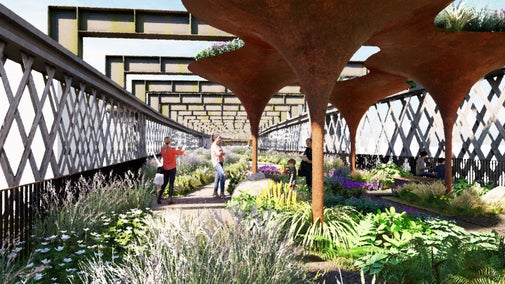
Donate
Everyone needs nature, now more than ever. Donate today and you could help people and nature to thrive at the places we care for.

This 330-metre-long steel viaduct sits in Castlefield, the oldest part of the city of Manchester. Once the site of the Roman fort of Mamucium and later a central hub for the industrial revolution, Castlefield is an area steeped in rich history. Here, we uncover the town’s past and reveal how the viaduct played a key role in Manchester’s story.
Castlefield’s story began in AD 79 , when Roman soldiers led by General Agricola chose the area as the site of a timber fort, which they called Mamucium. It was a strategic position, protected by the Rivers Irwell and Medlock, and well-located to guard important roads towards the larger Roman forts at York, Chester and Ribchester.
Over time the fort was repaired and enlarged, and eventually rebuilt in stone. A village (known as a 'vicus') was established nearby to supply the fort, but once the Romans left around AD 410, both the fort and the village declined and were eventually abandoned.
In 1086 a village called ‘Mamcester’ was recorded in the Domesday book, lying around a kilometre north-east of the old fort. It grew steadily, incorporating the site of the fort which was now known as Castlefield, and became a town in the early 13th century. However, it wasn’t until the late 18th century that the area really began to put itself on the map.
Manchester’s industrial heritage began around 1758, when the Duke of Bridgewater commissioned James Brindley to construct one of Britain’s first canals to transport coal from his mines at Worsley to Manchester.
The Bridgewater canal proved a huge success, halving the price of coal and prompting a period of intensive canal-building across the country. When the Rochdale canal was complete in 1804 it was joined to the Bridgewater canal at Castlefield, making this area the hub of the canal network.
By this time Manchester was the fastest growing city in the world, thanks to the ever-increasing number of cotton mills creating jobs and bringing trade into the city. Eventually it became clear that the canals alone couldn’t move goods efficiently – leading to the dawning age of the railway.

In 1830 Castlefield became the site of world’s first inter-city passenger railway station: Manchester Liverpool Road. Over the next several decades the area became the central hub for Manchester’s goods transportation network.
Warehouses sprang up all over Castlefield to support the network, and in 1855 construction began on Great Northern Warehouse. It was designed to be a three-way warehouse served by canal, road and rail, and in 1891 construction began on a viaduct which would carry the railway line to both the warehouse and the adjacent Central Station.
The viaduct itself was constructed by Heenan and Froude, the engineers who built the iconic Blackpool Tower. Upon the viaduct’s completion, a local newspaper report declared it ‘a triumph of engineering skill,’ and stated that ‘some notion may be formed of the nature and importance of [the viaduct] from the fact that the total cost has amounted to £250,000.’
For the next 77 years the viaduct was used to carry heavy rail traffic in and out of the area, until it finally closed in 1969.
Since its closure, the viaduct has remained a focal feature of the Castlefield skyline, even serving as a backdrop to TV series such as Coronation Street and Peaky Blinders, the latter of which made use of the viaduct’s shadowy archways and looming industrial bulk to evoke 1920s Birmingham. The viaduct was also used as inspiration for the ‘Motostoke’ area in the Pokemon Sword/Shield games, which is based on Manchester.
As canal and rail transport declined, the surrounding area became a space for leisure and tourism. The Liverpool Road station became the Science and Industry Museum, and various other cultural venues were established, from concert venues to a reconstruction of the old Roman Fort.
Through this exciting project, we hope that the viaduct will soon join its near neighbours as a core part of Castlefield’s vibrant cultural scene.

Everyone needs nature, now more than ever. Donate today and you could help people and nature to thrive at the places we care for.
Learn about the vision for Castlefield Viaduct and about the work we're doing in partnership with Manchester to transform this historic structure into an urban park for people and nature.

Find out how we’re working to combat climate change at Castlefield Viaduct, as part of a project to transform this historic structure into an urban green space.

Explore a garden in the sky at Castlefield Viaduct in Manchester, where you can discover the history of the structure and find out more about the ideas for the future of this Grade II-listed Victorian viaduct.

Learn about people from the past, discover remarkable works of art and brush up on your knowledge of architecture and gardens.
